Since my daughter joined her high school Color Guard team over a year ago the sport has fascinated me! The amount of effort she puts into practice and learning to perform her art is more than I ever imagined it would be. I absolutely love watching every performance.
In the beginning, I knew very little about what Color Guard does. Because I’m the type of person that really enjoys understanding a subject completely, I had to take a deeper dive into what Color Guard is. Now I’m happy to share what I have learned with you.
Color Guard or Flag Corps are teams of performers who combine the use of flags, sabers, rifles, and other props or equipment to perform choreographed dances and routines that enhance the visual effect of a Marching Band or Drum Corps.
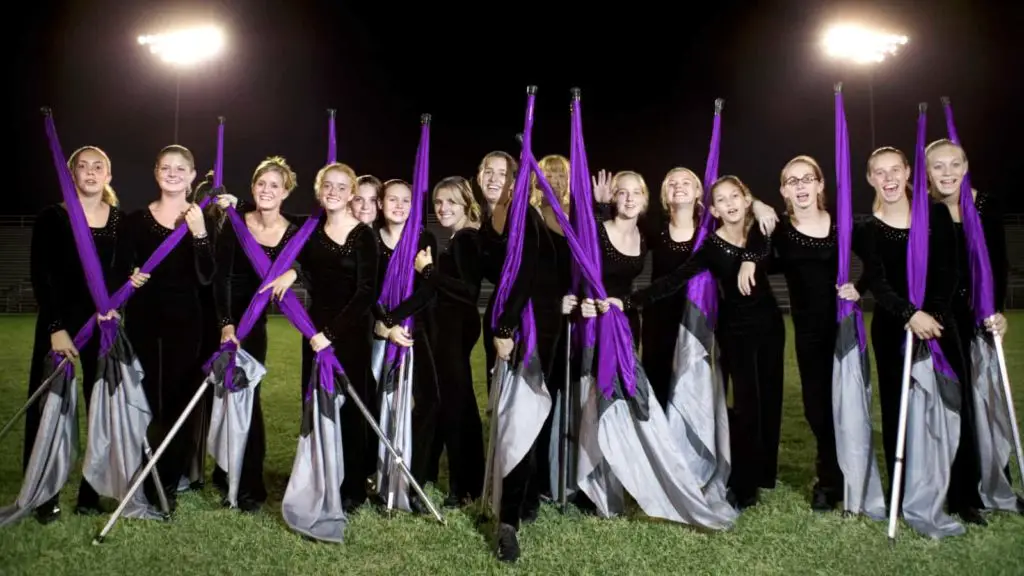
They are the flag twirlers, baton throwers, saber wielding dancers that make Marching Band a lot of fun. The visual effect that they add with the colorful flags and interpretive dance movements can make the difference from a humdrum-boring halftime show to a stellar overall visually spectacular performance.
In this article, we will take a deeper dive into what Color Guard really is.
What is Color Guard?
Color Guard is a non-instrument playing auxiliary group to a Marching Band in High School or College or the military. They add to the showmanship and performance of the band by using flags, rifles, sabres, and other props. In Marching Band competitions their performance adds to the total score.
I like to think of Color Guard going hand and hand with the band like how milk goes with Oreos, and butter with bread. You could have one without the other, but why would you want to!
Color Guard adds flare and pizazz to a marching band show. They add color, movement, fun, and visual interest!
Generally, Color Guard will perform with a Marching band on a football field during the halftime show. They will spin throw and use the synchronized movement of different props like flags, sabres (long dull swords), and rifles (only mock ones not the real things) to create a dance performance that interprets the music the Marching Band, Drum Corps, or Bugle Corps is playing.
Even though their uniforms are often different than that of the rest of the band, Color Guard is just as much part of the Marching Band or Drum Corps as any other member that is playing an instrument.
Color Guard can also be a stand-alone group (usually referred to as Winter Guard or indoor Color Guard) that performs to pre-recorded music, or a smaller stationary musical ensemble or group. A winter Guard will generally perform in a gymnasium indoors.
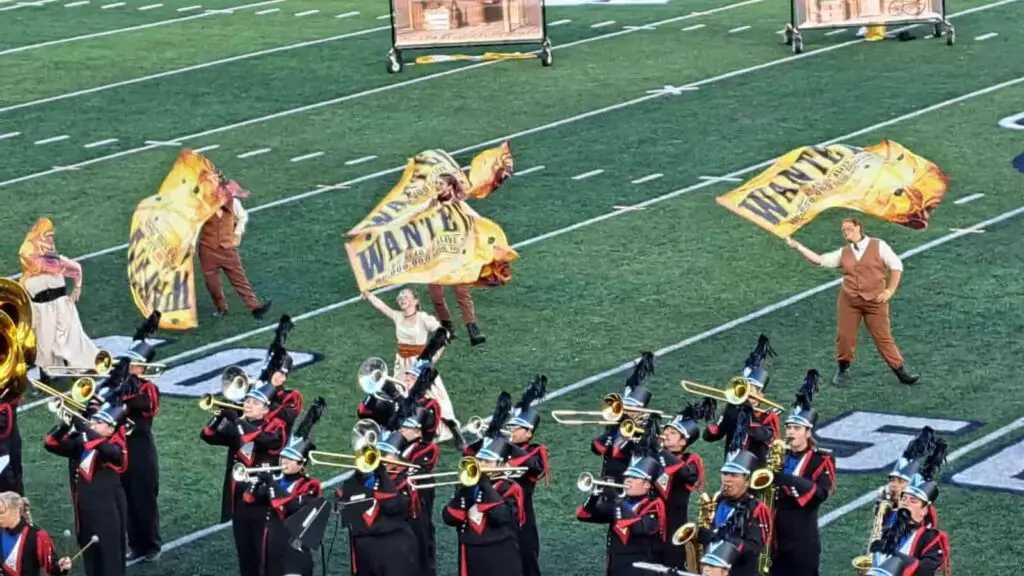
Do Color Guard Members Have to Play an Instrument?
Color Guard members usually don’t play instruments. At my daughter’s school, a lot of the Color Guard members are members of the choir as well. They all have a good understanding of music, rhythm, and musical timing, which can help a Color Guard member do better in staying in sync and coordinating with the band.
Some band directors do require the Color Guard members to play an instrument. A lot of times it may be oboe or bassoon players that can’t march with their instrument or maybe extra members of the flute section. They may do this in order to ensure that the members of the Color Guard have a strong foundational understanding of music.
History of Color Guard
The Color Guard gets its roots from the military. During the 18th and 19th centuries, Flags were referred to as “the Colors.” Specific soldiers were assigned to “guard” or protect the colors (flag). Each regiment was assigned a specific color/flag in order to be able to rally around it in time of battle.
Flags have always been an important part of history. They often represent the pride and unity of a group or nation. They are respected and revered as a symbol of beliefs and values. In battle, flags are often used to inspire bravery and as a reminder to the soldiers of what they are fighting for.
In the British Army, this was extended when each regiment or brigade was assigned a color. Before the battle, they would ceremoniously march and parade with their colors held high. This ceremony was called “Trooping of the Colors” and helped the men in the brigades memorize their flags before the battles.
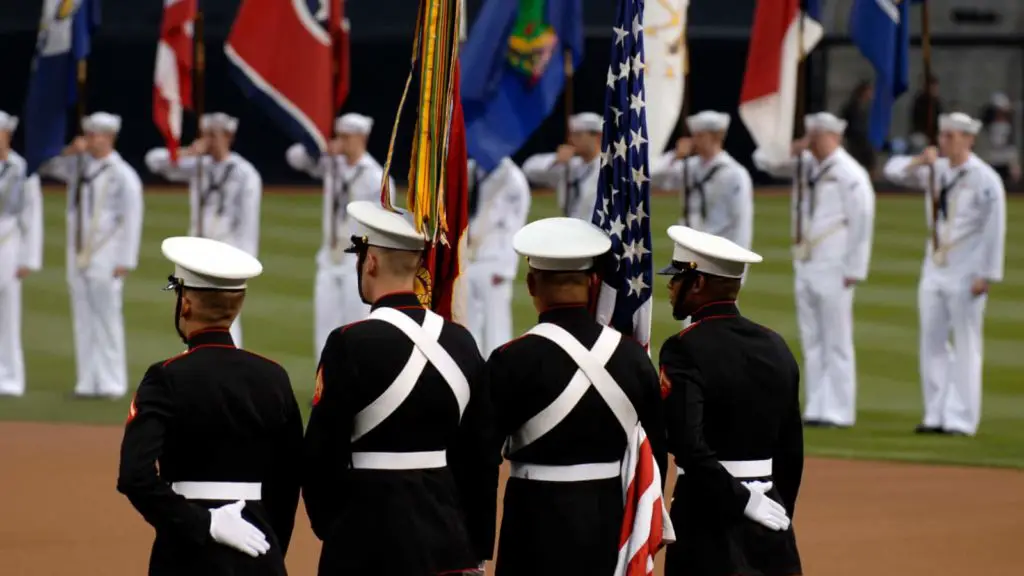
Soon drums and bugle corps were formed to play music during this parade in order to rally the troops and celebrate the Color Guard at the front of the lie. During the civil war, there would often be entire marching bands promoting and celebrating the Color Guard.
Guarding or holding the colors in this ceremony and into battle was an honor and a very important and sacred duty. In the battle on the front lines holding the colors was a hugely important job. The men holding the colors would get their orders directly from the commanding officer.
Because the flags could be seen above the smoke of the battle soldiers would look to the colors to see when they needed to advance on the enemy or create a rallying point when things got too crazy and the soldiers needed to regroup. If the colors retired then the entire regiment would retire.
Because the colors were so important it was often a big move for an opposing regiment to capture the colors of their enemies. Doing this could essentially disarm an entire brigade. This is why “Guarding” the colors was so important!
Color Guard Today
Color Guard continues to be an important part of military ceremonies as well as in other groups such as Boy Scouts presenting of the colors,
Color Guard in Marching bands today get a lot of their traditions from this military background, from the flags they hold to the sabres, and rifles they spin.
There seemed to be a major shift in Color Guard when a lady named Peggy Twiggs came up with the move called the “Peggy Spin.” Peggy who was in the Drum Corps International (DCI) in the early 70s had noticed that the Drum Corps seemed to be doing a lot of twists and spins in their routines and so Peggy decided to make her Color Guard team more extravagant with tosses and twists.
Before this most Color Guard teams would just march and move the flags at angles. Peggy’s style caught on quickly and became more widespread helping to create what we now know as the Color Guard sport today.
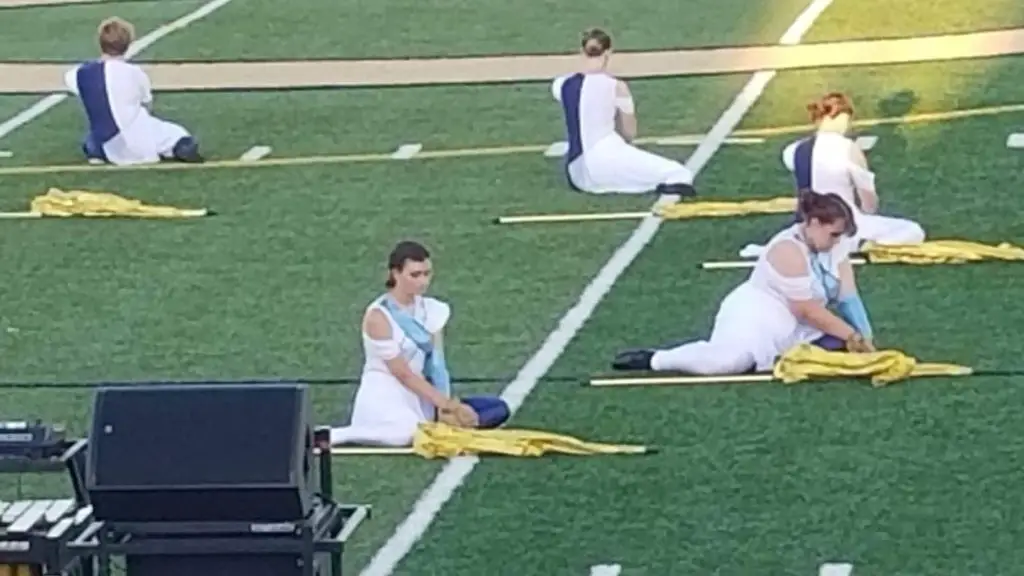
Color Guard Competitions
Color Guards compete alongside Marching Bands, Drum, and Bugles Corps in competitions. They will get a stand-alone score that will also factor into the total overall score for the band.
Some Color Guards also compete after the Marching Band season is over. This is usually called Winter Guard. While the band is involved in Symphonic band or other smaller ensembles the Winter Guard performs indoors independent of what the band is doing.
There is an association called Winter Guard Internation (WGI) that regulates and judges competitive Winter Guards. Many winter Guards are supported by educational institutions, but some are private clubs or organizations that require extensive tryouts and membership fees. It is a growing sport with more than 33,000 participants at the regional level for the last WGI competition.
Top Tip: Wondering where the color guard fits in with the band? Check out our article Marching Band Positions & Organization!
Why is it Called Color Guard?
Color Guard gets its name from when it started with soldiers that were responsible for guarding the regimental flag, or colors. Each unit would march with an appointed Guard defending the Colors from attack. Flags, sabres, and rifles all come from the military roots of the Color Guard.
What Does Color Guard Do?
Color Guard teams perform with the Marching Band, Drum Corps, or Bugle Corps at football halftime shows, in parades, and at competitions. In the off-season, they perform their own separate shows in Winter Guard. Their main purpose is to interpret the music that is being played through dance and synchronized movements.
Color Guard will practice for hours and hours a day to perfect their flag spinning tossing and catching.
One of the coolest things about watching Color Guard is seeing all the neat props they use. They use flags, sabres, rifles, air blades and other props to thrill and entertain. Generally, their props are chosen based on the music the marching band is playing.
I’ve seen some groups use pool noodles for a beach-themed show. I’ve seen a Color Guard group use lassos, and rifles for a western-style show. From boas to streamers, hula hoops to all different sizes of flags the options for Color Guar props are as endless as the group’s imagination.
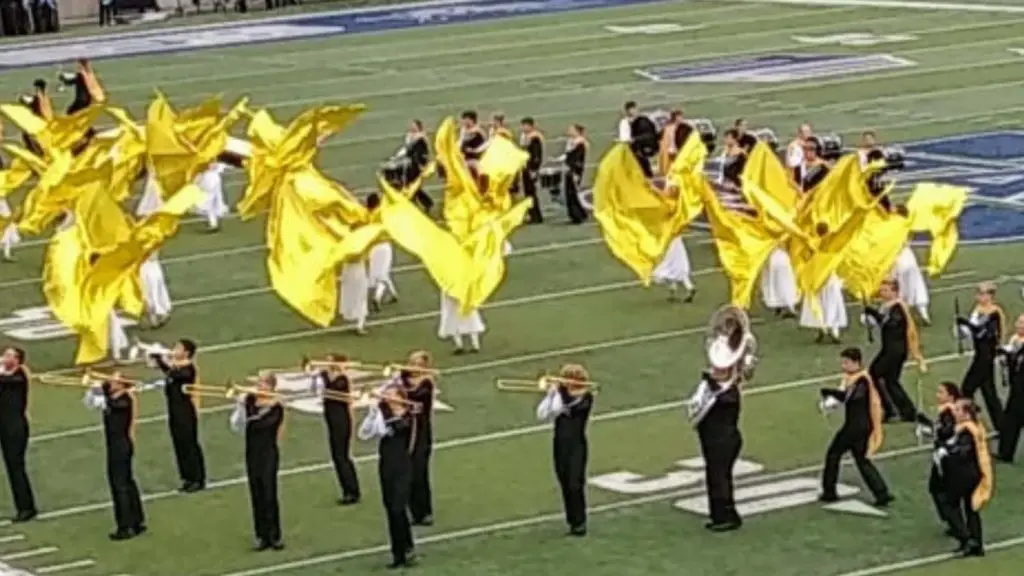
Is Color Guard Hard?
Here are some reasons why Color Guard can be very challenging.
- It requires many long practices with hours of physical work.
- It requires dedication, and commitment.
- Performing in wind and rain can be very challenging and tiresome.
- Color Guard members may get injured while throwing and trying to catch their flag sabre or rifle.
- It requires sacrifice for the good of the team.
- It requires a lot of physical movement and flexibility.
Top Tip: Want to learn what else is challenging about being in the color guard? Check out this article: 10 Reasons Color Guard is Hard (Is it Worth it?)
When to Do Color Guard
As with any sport (yes Color Guard is a sport). The earlier you start the better. This may also depend on how competitive Color Guard is in your area. For highly competitive Marching Bands and Winter Guards, middle schools will often have a beginner team that will teach the basics and feed into the high school.
Most Color Guard members start their first year of high school. This was the case for my daughter. In the spring of her 8th-grade year (last year of middle school) the high school offered a clinic teaching the basics and then allowed future 8th and 9th graders to try out.
In the past, membership in competitive color guards was limited to those under 22 years of age, but Winter Guard International (WGI), has removed the age limit for the highest class of Winter Guard Groups.
It is not common for someone who has never done Color Guard before to start fresh in college, but it isn’t unheard of. If you have a lot of natural abilities from doing dance or you have had experience being a Majorette then joining a university or college team might be easier than you think.
How to Join Color Guard
Finding out what groups are in your area is the first step to joining a Color Guard team. Check with your local high school and middle school marching band programs. Talking directly to the band director or whoever is in charge of the music department can help you know what options your school has for Color Guard.
If you are in a smaller community and your high school doesn’t have a Color Guard or Marching Band your nearest colleges or universities may have suggestions on how to find a group in your area.
There are many Facebook pages for local Color or Winter Guard groups. You can also check the Winter Guard International website. They don’t have a directory, but they do have multiple ways you can contact them to get more information.
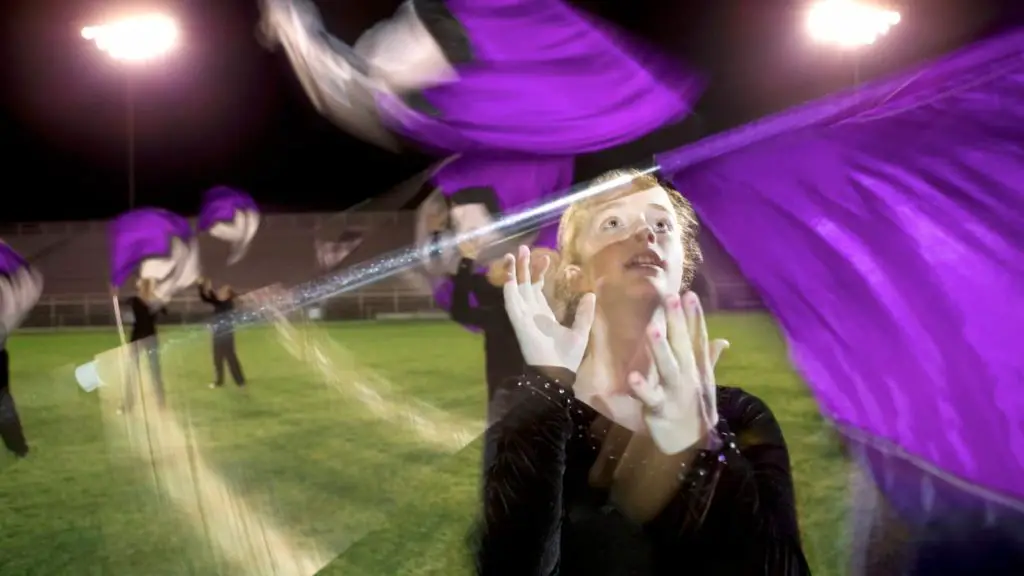
How to Prepare for Color Guard
Knowing what you are signing up for is important. Color Guard takes a lot of dedication and commitment. It takes time to practice and many weekends away from family or friends for performances.
🎵 Note: Color Guard will generally practice as much as the Marching Band and sometimes more. Because it is so physically demanding in order to prepare for Color Guard it’s best if you are in good shape.
You will be outside in the elements for a good portion of the Marching Band season. If you don’t like being in the sun, or you hate getting wet when it rains Color Guard may not be for you.
The Start of the Color Guard season is generally Band Camp in the summertime. Band camp can be physically demanding as not only are you learning to march you will be learning how to twirl and toss your flags.
There is usually a week of basics where you will work with just the Color Guard team to get the basic moves down well, then the following week is all day with the marching band learning drills and starting to put together the show. Depending on the band you may need to learn more than 1 routine for the season’s shows.
How Many People Can Be in Color Guard
Color Guards can have a wide range in the number of members. I’ve seen color guards with just one member all the way to 50 or more. Generally, the Color Guard team will be balanced with the amount of people in the Marching Band. A good size is about 1/4-1/3 the number of band members.
Up Next: All About Color Guard Flags (Complete Guide)
10 Reasons Color Guard is Hard (Is it Worth it?)
Disclaimer: This post may contain affiliate links. We only recommend high-quality products that are used and recommended by real musicians. If you use these links to buy something we earn a small commission.
